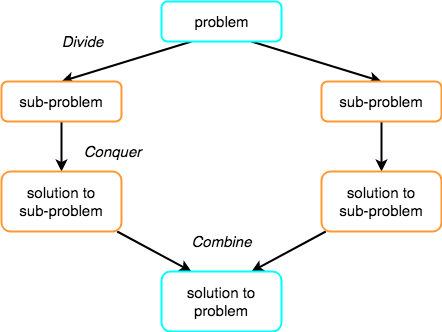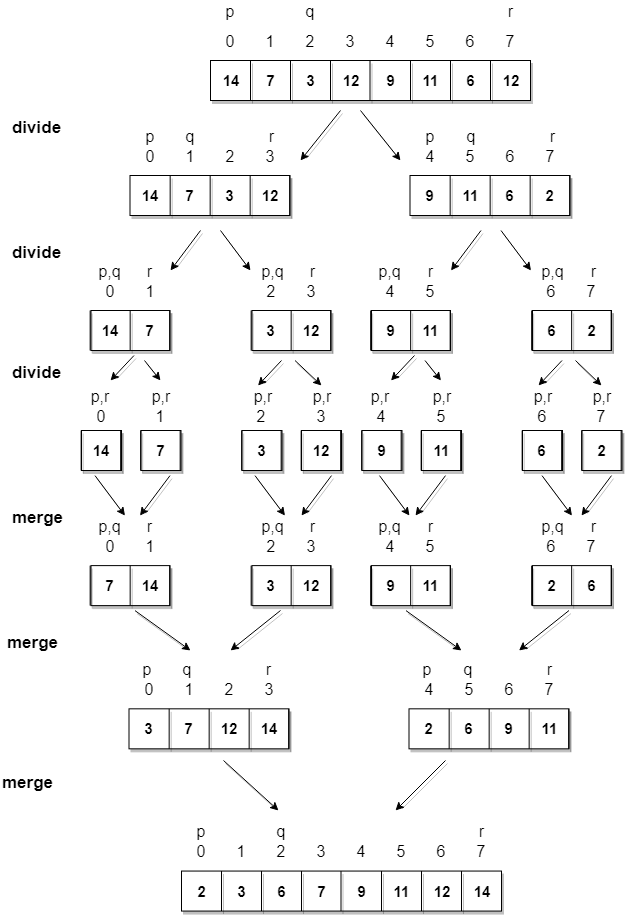Merge Sort Algorithm
Merge Sort follows the rule of Divide and Conquer to sort a given set of numbers/elements, recursively, hence consuming less time.
In the last two tutorials, we learned about Selection Sort and Insertion Sort, both of which have a worst-case running time of
O(n2). As the size of input grows, insertion and selection sort can take a long time to run.
Merge sort , on the other hand, runs in
O(n*log n) time in all the cases.
Before jumping on to, how merge sort works and it's implementation, first lets understand what is the rule of Divide and Conquer?
Divide and Conquer
If we can break a single big problem into smaller sub-problems, solve the smaller sub-problems and combine their solutions to find the solution for the original big problem, it becomes easier to solve the whole problem.
Let's take an example, Divide and Rule.
When Britishers came to India, they saw a country with different religions living in harmony, hard working but naive citizens, unity in diversity, and found it difficult to establish their empire. So, they adopted the policy of Divide and Rule. Where the population of India was collectively a one big problem for them, they divided the problem into smaller problems, by instigating rivalries between local kings, making them stand against each other, and this worked very well for them.
Well that was history, and a socio-political policy (Divide and Rule), but the idea here is, if we can somehow divide a problem into smaller sub-problems, it becomes easier to eventually solve the whole problem.
In Merge Sort, the given unsorted array with
n elements, is divided into n subarrays, each having one element, because a single element is always sorted in itself. Then, it repeatedly merges these subarrays, to produce new sorted subarrays, and in the end, one complete sorted array is produced.
The concept of Divide and Conquer involves three steps:
- Divide the problem into multiple small problems.
- Conquer the subproblems by solving them. The idea is to break down the problem into atomic subproblems, where they are actually solved.
- Combine the solutions of the subproblems to find the solution of the actual problem.

How Merge Sort Works?
As we have already discussed that merge sort utilizes divide-and-conquer rule to break the problem into sub-problems, the problem in this case being, sorting a given array.
In merge sort, we break the given array midway, for example if the original array had
6 elements, then merge sort will break it down into two subarrays with 3 elements each.
But breaking the orignal array into 2 smaller subarrays is not helping us in sorting the array.
So we will break these subarrays into even smaller subarrays, until we have multiple subarrays with single element in them. Now, the idea here is that an array with a single element is already sorted, so once we break the original array into subarrays which has only a single element, we have successfully broken down our problem into base problems.
And then we have to merge all these sorted subarrays, step by step to form one single sorted array.
Let's consider an array with values
{14, 7, 3, 12, 9, 11, 6, 12}
Below, we have a pictorial representation of how merge sort will sort the given array.

In merge sort we follow the following steps:
- We take a variable
pand store the starting index of our array in this. And we take another variablerand store the last index of array in it. - Then we find the middle of the array using the formula
(p + r)/2and mark the middle index asq, and break the array into two subarrays, fromptoqand fromq + 1torindex. - Then we divide these 2 subarrays again, just like we divided our main array and this continues.
- Once we have divided the main array into subarrays with single elements, then we start merging the subarrays.
Implementing Merge Sort Algorithm
Below we have a C program implementing merge sort algorithm.
/*
a[] is the array, p is starting index, that is 0,
and r is the last index of array.
*/
#include <stdio.h>
// lets take a[5] = {32, 45, 67, 2, 7} as the array to be sorted.
// merge sort function
void mergeSort(int a[], int p, int r)
{
int q;
if(p < r)
{
q = (p + r) / 2;
mergeSort(a, p, q);
mergeSort(a, q+1, r);
merge(a, p, q, r);
}
}
// function to merge the subarrays
void merge(int a[], int p, int q, int r)
{
int b[5]; //same size of a[]
int i, j, k;
k = 0;
i = p;
j = q + 1;
while(i <= q && j <= r)
{
if(a[i] < a[j])
{
b[k++] = a[i++]; // same as b[k]=a[i]; k++; i++;
}
else
{
b[k++] = a[j++];
}
}
while(i <= q)
{
b[k++] = a[i++];
}
while(j <= r)
{
b[k++] = a[j++];
}
for(i=r; i >= p; i--)
{
a[i] = b[--k]; // copying back the sorted list to a[]
}
}
// function to print the array
void printArray(int a[], int size)
{
int i;
for (i=0; i < size; i++)
{
printf("%d ", a[i]);
}
printf("\n");
}
int main()
{
int arr[] = {32, 45, 67, 2, 7};
int len = sizeof(arr)/sizeof(arr[0]);
printf("Given array: \n");
printArray(arr, len);
// calling merge sort
mergeSort(arr, 0, len - 1);
printf("\nSorted array: \n");
printArray(arr, len);
return 0;
}
Given array: 32 45 67 2 7 Sorted array: 2 7 32 45 67
Complexity Analysis of Merge Sort
Merge Sort is quite fast, and has a time complexity of
O(n*log n). It is also a stable sort, which means the "equal" elements are ordered in the same order in the sorted list.
In this section we will understand why the running time for merge sort is
O(n*log n).
As we have already learned in Binary Search that whenever we divide a number into half in every stpe, it can be represented using a logarithmic function, which is
log n and the number of steps can be represented by log n + 1(at most)
Also, we perform a single step operation to find out the middle of any subarray, i.e.
O(1).
And to merge the subarrays, made by dividing the original array of
n elements, a running time of O(n) will be required.
Hence the total time for
mergeSort function will become n(log n + 1), which gives us a time complexity of O(n*log n).
Worst Case Time Complexity [ Big-O ]: O(n*log n)
Best Case Time Complexity [Big-omega]: O(n*log n)
Average Time Complexity [Big-theta]: O(n*log n)
Space Complexity: O(n)
- Time complexity of Merge Sort is
O(n*Log n)in all the 3 cases (worst, average and best) as merge sort always divides the array in two halves and takes linear time to merge two halves. - It requires equal amount of additional space as the unsorted array. Hence its not at all recommended for searching large unsorted arrays.
- It is the best Sorting technique used for sorting Linked Lists.

0 comments:
Post a Comment